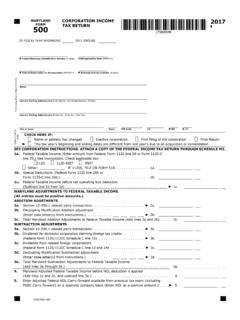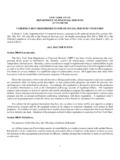Transcription of Basel Committee on Banking Supervision
1 Basel Committee on Banking Supervision Basel III definition of capital Frequently asked questions September 2017 (update of FAQs published in December 2011) This publication is available on the BIS website ( ). Bank for International Settlements 2017. All rights reserved. Brief excerpts may be reproduced or translated provided the source is stated. ISBN 978-92-9259-094-9 (online) Basel III definition of capital Frequently asked questions iii Contents Paragraphs 52 53 (Criteria for Common Equity Tier 1) .. 1 Paragraphs 54 56 (Criteria for Additional Tier 1 capital).
2 3 Paragraphs 60 61 (Provisions) .. 7 Paragraphs 62 65 (Minority interest and other capital that is issued out of consolidated subsidiaries that is held by third parties) .. 7 Paragraphs 67 68 (Goodwill and other intangibles) .. 9 Paragraphs 69 70 (Deferred tax assets) .. 9 Paragraphs 76 77 (Defined benefit pension fund assets and liabilities) .. 10 Paragraphs 78 89 (Investments in own shares, investments in the capital of Banking financial and insurance entities and threshold deductions) .. 10 Paragraphs 94 96 (Transitional arrangements) .. 14 Press release 13 January 2011 (Loss absorbency at the point of non-viability).
3 18 General questions .. 20 Annex 1: Flowchart to illustrate the application of transitional arrangements in paragraph 94(g) of the Basel III rules text .. 22 Annex 2: Flowchart to illustrate the application of transitional arrangements in paragraph 95 of the Basel III rules text .. 23 Basel III definition of capital Frequently asked questions 1 Basel III definition of capital - Frequently asked questions The Basel Committee on Banking Supervision has received a number of interpretative questions related to the definition of capital incorporated in the Basel III framework.
4 To help ensure a consistent global implementation of Basel III, the Committee periodically reviews frequently asked questions and publishes answers along with any technical elaboration of the rules text and interpretative guidance that may be necessary. This document adds the fourth set of frequently asked questions (FAQs) that relate to the definition of capital sections of the Basel III rules text to the first three sets published in July, October and December 2011. The questions and answers are grouped according to the relevant paragraphs of the rules text. FAQs that have been added or amended since the publication of the third version of this document are denoted in italics and comprise: Paragraphs 52-53, Q6 Paragraphs 54-56, Q17, Q18 and Q19 Paragraphs 78-89, Q18 Paragraphs 94-96, Q2, Q4, Q6, Q7, Q10, Q21 and Q22 Press release 13 January 2011, Q10 General questions, Q3 Two flowcharts are also included in the annexes.
5 These flowcharts are designed to aid understanding of the application of the Basel III transitional arrangements to capital instruments issued by banks. Paragraphs 52 53 (Criteria for Common Equity Tier 1) 1. Does retained earnings include the fair value changes of Additional Tier 1 and Tier 2 capital instruments? Retained earnings and other reserves, as stated on the balance sheet, are positive components of Common Equity Tier 1. To arrive at Common Equity Tier 1, the positive components are adjusted by the relevant regulatory adjustments set out in paragraphs 66 90 of the Basel III rules text.
6 No regulatory adjustments are applied to fair value changes of Additional Tier 1 or Tier 2 capital instruments that are recognised on the balance sheet, except in respect of changes due to changes in the bank s own credit risk, as set out in paragraph 75 of the Basel III rules text. For example, consider a bank with common equity of 500 and a Tier 2 capital instrument that is initially recognised on the balance sheet as a liability with a fair value of 100. If the fair value of this liability on the balance sheet changes from 100 to 105, the consequence will be a decline in common equity on the bank s balance sheet from 500 to 495.
7 If this change in fair value is due to factors other than own credit risk of the bank, eg prevailing changes in interest rates or exchange rates, the Tier 2 capital instrument should be reported in Tier 2 at a valuation of 105 and the common equity should be reported as 495. 2 Basel III definition of capital Frequently asked questions 2. Where associates and joint ventures are accounted for under the equity method, are earnings of such entities eligible for inclusion in the Common Equity Tier 1 capital of the group? Yes, to the extent that they are reflected in retained earnings and other reserves of the group and not excluded by any of the regulatory adjustments set out in paragraphs 66 to 90 of the Basel III rules text.
8 3. Criteria 14 requires common shares to be clearly and separately disclosed on the bank s balance sheet . Does balance sheet refer to that in the audited and published financial statements? Is it only for the balance sheet at end of financial year? Does disclosure have to be both for the standalone bank and on a consolidated group basis? This requirement is about the nature of the item, ie that it is separately disclosed on the face of a bank s balance sheet, and not about the frequency of the disclosure. In the context of the nature, yes, it is the balance sheet in the audited financial statements as published in the annual report.
9 The Basel requirements are for consolidated group levels, and the treatment at an entity level should follow the domestic requirements. As for the frequency, where a bank publishes results on a half yearly or quarterly basis disclosure should also be made at those times. 4. Footnote 10 of paragraph 52 includes the sentence: The Committee will continue to review the appropriate treatment of unrealised gains, taking into account the evolution of the accounting framework. Does the Committee have any further guidance on this issue? The Committee continues to review the appropriate treatment of unrealised gains taking into account the evolution of the accounting framework and any other relevant information.
10 Absent any new guidance, the minimum requirements established by Basel III do not apply any adjustment that would remove from Common Equity Tier 1 unrealised gains and losses. 5. Criterion 11 for common shares and criterion 1 for Additional Tier 1 and Tier 2. Does paid-in have to be paid-in with cash? Paid-in capital generally refers to capital that has been received with finality by the bank, is reliably valued, fully under the bank's control and does not directly or indirectly expose the bank to the credit risk of the investor. The criteria for inclusion in capital do not specify how an instrument must be paid-in.














